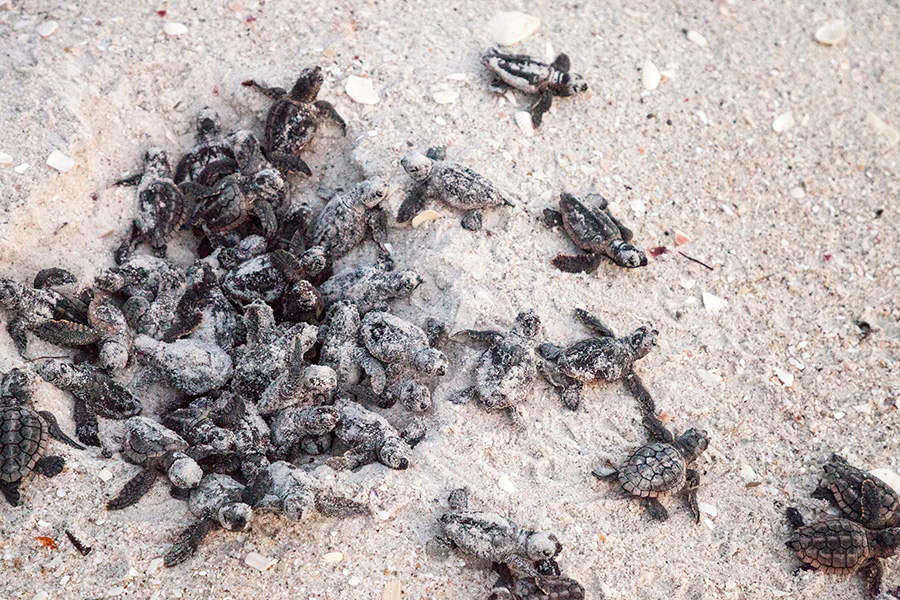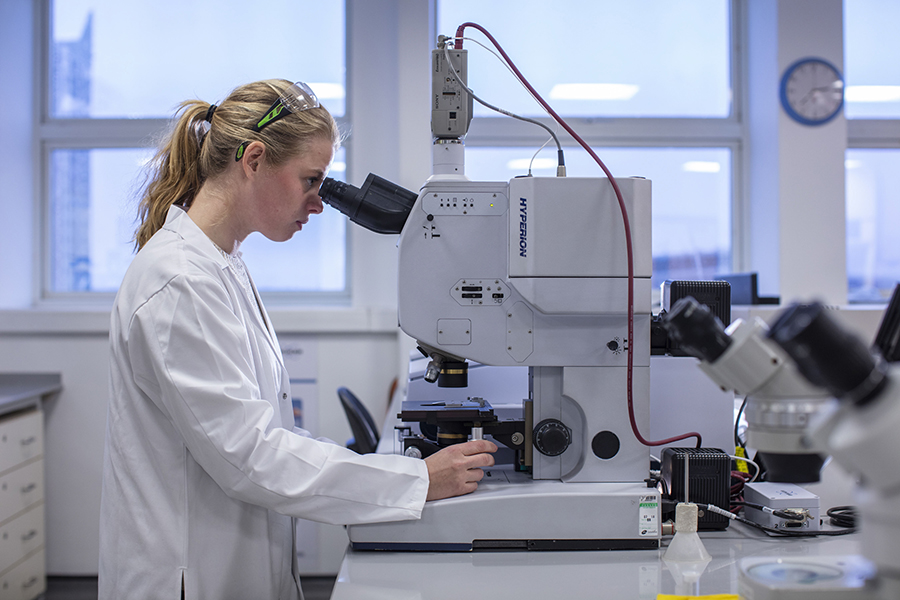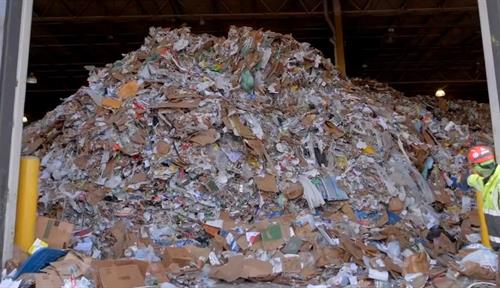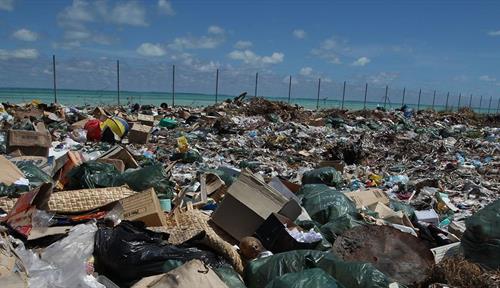Our world is increasingly plastic. Back in the 1950s, humanity produced just 5 million metric tons of plastic per year; today it’s 400 million metric tons. Since plastic can take hundreds or thousands of years to biodegrade, pretty much all of it is still around, except for the roughly 20 percent that’s been burned. By some estimates, there are now eight gigatons of accumulated plastic on Earth — twice as much as the weight of all animal life.
Much of this plastic is still in use, in products like cars and homes, but a lot is junk; 40 percent of plastic production goes toward packaging that’s typically tossed after being used once. Some of our plastic waste is recycled, responsibly incinerated or properly landfilled, but tens of millions of tons are mismanaged annually — burned in open pits or left to pollute the environment. Plastic pollution has been found at the poles and the bottom of the ocean, in our clouds and soils, in human blood and mothers’ milk. If things keep going as they are, it is predicted that annual rates of plastic flowing into the sea will triple from 2016 to 2040.
The impacts are manifold. Debris can choke and tangle wildlife; even zooplankton can fill up on microplastics instead of food, altering how much oxygen is in the ocean. And some of the chemicals used in plastics — including additives that make plastics flexible or fire-resistant — can leach out into water, soil or our bodies. Some of these are carcinogenic or endocrine disruptors, capable of interfering with development or reproduction. The net impacts of our lifelong exposure to this chemical soup are hard to tease out, but one recent study concluded that it cost the United States $249 billion in extra health care in 2018.
Delegates are working now on the world’s first plastic pollution treaty, which is due to be completed by the end of this year. That treaty might cap plastic production, phase out problem chemicals and regulate how waste is managed — but how ambitious this treaty will be is yet to be seen. (See box.)
Imogen Napper, a marine science postdoc at the University of Plymouth in the United Kingdom who specializes in plastic pollution, is one of many scientists whose research is informing the treaty process. Her detective work has documented plastic pollution in surprising places and pointed to solutions that have made their way into government regulations around the world. Knowable Magazine spoke with her about the plastic problem and what we can all do about it. This conversation has been edited for length and clarity.
Why did you decide to focus on plastic pollution as a researcher?
I was lucky to grow up in a small seaside town in the southwest of the UK. I don’t remember any discussion about plastic pollution or beach cleanups when I was younger. But now, going back home, plastic pollution is one of the most obvious environmental challenges that we have, because it’s so visible.
I’m hoping that plastic pollution can be used as a gateway issue to other environmental concerns. Climate change, I’d argue, is a far bigger beast than plastic pollution. But for plastic pollution, we’ve got all the tools that we need — we’ve got potential solutions, and discussion happening now through the plastics treaty. We have that burning fire of desire to make a change. We can fix it.
You and many other researchers spend a lot of time documenting where plastic is in the wild, and how it gets there. Why is this so hard?
When it comes to microscopic pieces in, say, a soil or water sample, it takes a lot of grunt work. I have spent a lot of time looking under the microscope trying to identify, just from the look of it, whether something is cellulosic — coming from plants, like cotton — or plastic. You get a good eye for it. But it can be really tricky.
Nor is it easy to document the accumulation and distribution of bigger, macro-sized chunks of plastic. There are so many sources, leakage points and places where plastic is building up. In one of our studies, led by Emily Duncan at the University of Exeter, we put GPS tags in plastic bottles and tracked them thousands of kilometers down the Ganges River. That sort of work helps to improve scientific models.
The commonly used estimate is that about 8 million metric tons of macroplastic enter the ocean each year. We know a lot less about the land. Technology is getting far better, with remote sensing, drones and satellite imagery. That will be very useful in the next few years to help us accurately identify how much plastic is going into the environment.

Plastic production has skyrocketed since the 1950s.
A lot of plastic litter is single-use products that have been tossed aside: In the UK, one survey showed that more than half of plastic litter was beverage-related, including cups, lids and straws. But some sources are more surprising, like tiny pieces of plastic thrown up by tire wear on highways.
That was also surprising to me. It’s so obvious — it’s right in front of you — but often we just don’t consider it. Research has only really focused on tire wear in the last few years, but it’s predicted to be one of the biggest single sources of microplastics — it has been estimated to make up five to 10 percent of the plastic entering the ocean.
In our lab, we have done a lot of research looking at clothing. I’d say about 60 percent of our wardrobe contains plastic, like polyester, acrylic or a natural-synthetic blend. A big part of my PhD research was centered around building a washing machine lab, and I tested for the first time different fabrics to see how many fibers would come off in a typical wash.
We found that for acrylic it was the most, at 700,000 fibers per wash. For polyester-cotton blend, it was a lot less, around 130,000 fibers. This started discussions about how we might make clothes differently or change our washing machines. In France, by 2025 all new washing machines will have to come with a filter, which is exciting. It’ll be really interesting to see how that develops. Ideally, the filter should be reusable, so we’re not just making more potential rubbish. There are a lot of different options; independent testing will be important.

Microplastic pollution has myriad sources. One major contributor that many of us don’t think about is wear from car tires.
CREDIT: ISTOCK.COM / SIMONKR
Where does all this plastic wind up?
You could argue that plastic really is everywhere. We did some research that found plastic fibers just below the summit of Mount Everest. In some regions, plastic microfibers can go down the drain into the sewage treatment plants; the collected solids, called sewage sludge, is then treated and then often applied on agricultural land as fertilizer. There’s evidence that the chemicals in those plastics can then be absorbed into plants.
There are some surprising ecological effects, too. I have read that some plastic pieces, because of their dark colors, absorb heat, which means they’re contributing to melting snow and ice.
Yes. Plastic can also increase sand temperature, and this has been found in turtle nesting sites. And turtle sex is dependent on the temperature of the sand. So we might end up with a lot more female turtles.
What’s the best thing to do with plastic at the end of its life?
Landfill isn’t great, but it does contain and control waste when done right. Incineration has pros and cons; it gets rid of the plastic and can be used to make energy. A lot of small island developing states may use incineration because they haven’t got the space for landfill, but then it’s often open burning, which is not good for the planet or your health.
People often think that recycling is a golden solution. But recycling is not fully circular — the recycled plastic is often made into a polymer of worsening quality. At some point, it will not be recyclable. Recycling can also generate problematic microplastics. And if there isn’t a market for the recycled material, it can end up in landfill.
None of this gets rid of the core issue. It’s just delaying it. I’m a big believer of tackling the problem at its source. My supervisor, Richard Thompson, says plastic pollution is like an overfilling bath. We’re very good at mopping up the floor, but the bath keeps overflowing. What we need to do is turn off the tap.

Newly hatched loggerhead sea turtles crawl out of a nest on a beach in Naples, Florida. Microplastic pollution increases the sand’s temperature — and temperature during egg incubation influences what sex hatchlings will be. In that way, plastic pollution can disturb turtle sex balance.
CREDIT: SUNFLOWERMOMMA / SHUTTERSTOCK
Are there good alternatives to conventional plastic, like biodegradable or compostable plastics, or bioplastics that are made from plants rather than from fossil fuels?
We did some research on this. We did a study looking at biodegradable carrier bags: We buried them in the soil, we submerged them in the ocean, and we left them hanging outside for three years. The ones outside completely fragmented into tiny bits — the plastic didn’t disappear, it just got smaller. The ones in the soil and in the ocean could still hold a full bag of shopping.
Biodegradable plastics that are marketed today need to go into a really specific waste management facility with high moisture, high heat, maybe a certain pH, to disappear.
Many bioplastics used today — such as bio-polyethylene — are chemically the same as other plastics, just made from a different source. They’re made from plant carbon instead of from fossil fuel carbon, but they may behave exactly like all other plastic. If they’re still single use, is that any better?
There’s a lot of work going into alternative products, but we need to be careful that they’re actually better for our health and the environment.

Imogen Napper looks through a microscope, searching for microplastics in samples.
CREDIT: COURTESY OF IMOGEN NAPPER
How is the plastics treaty (see box) coming along?
It’s going to take a lot of discussion, and I will be delighted if it happens this year, but realistically, I think it is going to take a little bit more time. It is difficult to get nations to agree to firm action, because a lot of it comes down to money — both the money to be made from manufacturing plastic, and the money it costs to deal with waste.
This is an amazing opportunity that we have, where globally we can have a unified decision on how to protect our planet. The treaty needs to be ambitious, it needs to be specific, and it needs to be binding.
Is it reasonable to think that some plastics might be banned?
Legislation has already banned some plastics and additives in some countries or regions. Our lab quantified microbeads in beauty products: We found that 3 million microbeads could be in a bottle of facial scrub. So there can be thousands in a squirt on your hand. We took this research, we published it, and then one day I came in to work and I had so many emails in my inbox from journalists. It was making quite a stir. And there were campaigns like “Beat the microbead,” because consumers didn’t want to wash their faces with plastic.
So the consumers started to boycott the products, then industry voluntarily removed microbeads and showcased that information in their own marketing. And then governments around the world started to ban microbeads in facial scrubs.
Research is all about providing information. And then, with that information, people can take it forward and make a change. I feel very privileged to be in a position that I can be part of that.
If you were in charge, would you ban specific plastics or chemicals?
I’d flip the question on its head and ask: What would I keep? We don’t need all the plastic we make. And instead of using a big chemical cocktail of additives that we don’t know anything about, let’s just have a list of the chemicals that we can use.
When I started my PhD, I wrongly thought that plastic was evil. Plastics are incredibly useful and can solve other environmental and health problems. Plastic can keep our food fresh, and food waste is a huge problem. During the pandemic, it helped to keep people safe. It is lightweight, so products need less energy for transport.
But let’s think, right from when we’re designing it, how can we make sure it’s sustainable? Often, we’re not thinking about that right at the beginning, we’re thinking about it far down at the end of its life.






